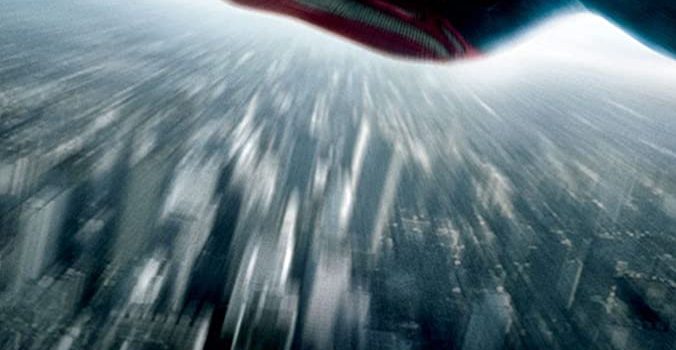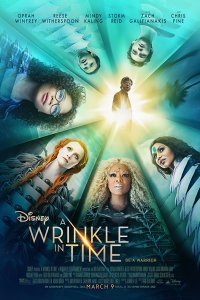‘This Man Is Not Our Enemy’: A Review of Man of Steel
 by Gary Westfahl
by Gary Westfahl
In the first version of an earlier review, I mistakenly described a moment from a film preview as part of the film itself – an inexcusable error, to be sure, but an understandable one, given the way that all contemporary action films increasingly blur together in one’s mind, each rigidly adhering to the same monotonous conventions. Figures with magical powers or high-tech vehicles race and chase each other through the sky at blinding speeds, sometimes aiming directly at the viewer (if it happens to be a 3D film); characters engage in long, brutal fistfights, repeatedly sending their opponents crashing into walls or the ground, with each blow accompanied by the absurdly over-amplified sound of crunching celery; objects ranging in size from cars to planets regularly explode in a colorful and spectacular fashion; and every so often, protagonists pause for a few minutes of conversation – to convey plot points, crack a joke, wax philosophical about the Deeper Meaning of beating the crap out of other people, or advance the romantic subplot, the five-minute chick flick embedded within every action movie for the presumed enjoyment of bored women dragged into the theatre by their boyfriends. And what is distinctively different about Man of Steel? One participant in all the mayhem is wearing a blue suit with a red cape.
All of this is to say that Man of Steel is generally a very ordinary film, and this is disappointing, since the track records of its creators – writers Christopher Nolan and David S. Goyer and director Zack Snyder – inspired the hope that this would be an extraordinary film, the definitive cinematic version of the Superman story. And yet, while the film gets many things right in its generally intelligent and respectful reinterpretation of this iconic superhero, it also gets some key things wrong – which provide telling commentary on how the world, and its films, have changed since Superman first appeared seventy-five years ago.
For the most part, Henry Cavill’s Superman is the same character that we have gotten to know in various comic books, films, and television programs – basically a very nice guy who really likes people but feels uncomfortable around them, inspiring a lifestyle of awkward isolation from the world interspersed with periodic acts of altruism, as I explained while reviewing the previous reboot of the franchise, Superman Returns (review here). Indeed, the film’s revision of his early adulthood seems more in keeping with his basic personality; for while such a man might heed his parents’ advice and dutifully go to college and get a steady job, as he does in most versions of the mythos, he might actually prefer to become an aimless drifter, as he does in this film, holding a series of menial jobs that always end when his obsessive desire to help others leads to an overly revelatory superhuman feat, requiring a quick departure before he might begin to bond with any co-workers. And though the film must eventually start pushing this wandering Superman toward his inevitable destination – becoming a reporter at the Daily Planet – he still seems likely to remain the same charming but socially inept superhero that the world has grown to love and admire.
However, in one key respect, Superman is ill-suited to serve as the centerpiece of a contemporary film franchise: he really, really doesn’t like to beat the crap out of other people. As I said, he likes other people; he always wants to help other people; and although he really can’t, he wants to be friends with other people. Thinking back to the comic book stories of the 1930s, 1940s, and 1950s that defined his character, one does not recall Superman clobbering Lex Luthor or kicking Mr. Myxylptlk back into the Fifth Dimension; rather, the images that come to mind are Superman fixing a hole in a dam to stop a flood, Superman catching a falling Lois Lane, Superman lifting a sinking boat out of the water, Superman extinguishing a house fire with his super-breath. I am not going to undertake a statistical study, but I am quite sure that a vast majority of his super-feats involved saving people, not hurting people. As one of the ironclad rules of the contemporary action movie, though, there must be a despicable villain, and the primary task of the hero is to defeat or destroy that villain – as discussed at length in my recent review of Star Trek into Darkness (review here). Thus, Superman’s longstanding proclivities must be adjusted to meet the requirements of the new order.
In this respect, Man of Steel provides a fascinating contrast to Star Trek into Darkness. The Star Trek franchise has always been about a crew of experienced professionals doing their jobs, and they are instinctively altruistic like Superman, while lacking his peculiar social issues. Forced into the role of good guys battling bad guys in their most recent film, these veterans viscerally resisted being recast in this fashion, providing the film with the dynamic psychodrama of characters battling against the story written for them. However, the Superman franchise, at least in most films and television programs, takes the form of a bildungsroman, the story of the education of a young superhero, guided by benevolent father figures towards his true destiny. Confronting what they regarded as more malleable stuff, then, writers Goyer and Nolan provide their film with a different undercurrent: the training of a young man to become a good guy who will happily battle bad guys.
The process of indoctrinating Superman involves certain obvious steps: first, you introduce a figure for the individual to learn to hate, here the Kryptonian supervillain General Zod (Michael Shannon). Second, you allow the individual to observe as the figure engages in one despicable act after another against people that the individual loves, progressing from anonymous strangers to the individual’s own mother, Martha Kent (Diane Lane). Finally, when the individual has attained the requisite level of loathing, he is placed right next to the hated figure in order to engage in a violent, cathartic battle. (No, one doesn’t need to precede that statement with “Spoiler alert!”; surely, every member of the audience will know, after five minutes of watching the film, that it will conclude with a vicious, no-holds-barred, extended slugfest between Superman and Zod, with Superman of course emerging victorious. It’s the law.)
What does require a (Spoiler alert!) is the exact outcome of that struggle, since we are given to understand that, with his final blow, Superman actually killed Zod (though this is not absolutely, positively established beyond a reasonable doubt, perhaps to leave an opening for the character to return in a sequel). By the standards of contemporary Hollywood, I suppose this means that Superman has passed his final exam. However, even the intimation that Superman might deliberately try to kill somebody, or might do so accidentally without expressing much regret, seems to violate his longstanding character as a hero who does not kill. After all, this is one aspect of his cultural heritage – it should be recalled that the only reason Zod is alive in the first place is that the Kryptonians, opposed to executing criminals, set up the Phantom Zone to exile them instead – and a key element in his kindly personality as well. However, since Superman and his audience have been programmed to despise Zod, his death was undoubtedly regarded as his most satisfying fate.
What was encouraging about Star Trek into Darkness is that, in its final scene, both its characters and creators appeared determined to move the franchise away from fashionable melodrama and back to its original spirit; what is disheartening about Man of Steel is that, in the end, both its hero and his creators appear perfectly content with their changed circumstances. And if the film is successful, one can be confident that the first story conference for Man of Steel 2 will begin with a smart producer saying, “Okay, this time, we’ve got to come up with a villain who is so unspeakably odious, so reprehensively evil, that he’ll make General Zod look like a Sunday school teacher!” And I’m sorry to contradict such smart producers, but fighting villains is simply not what Superman is all about.
It might be objected that the film does include several scenes of Superman rescuing people in his classic manner, and that Jor-El (Russell Crowe) briefly makes a case for cooperative behavior in stating that he wished his son Kal-El to serve as “a bridge” between the peoples of Earth and Krypton. It is also interesting that during Superman’s battle with Zod’s associate Faora-Ul (Antje Traue), she argues that the Kryptonians have an “evolutionary advantage” over Superman because they lack his sense of morality; in having Superman defeat the character, the film is symbolically contradicting her position to show, correctly, that it is their altruism that truly provides humans with an “evolutionary advantage.” But a film defines itself by the way that it ends, and while Star Trek into Darkness concluded by denouncing its own plot (and, not incidentally, leaving its villain alive), Man of Steel validates its own plot by slaughtering Zod, when it should have ended with Superman pressing a button to send him back to the Phantom Zone.
So, if they do end up making a second Superman film, I would first advise Christopher Nolan and David S. Goyer to carefully consider one of their own lines: when Colonel Nathan Hardy (Christopher Meloni) belatedly recognizes Superman’s benevolence, he tells his soldiers, “This man is not our enemy.” Indeed; Superman is not anyone’s enemy, and he should never be portrayed in those terms. I might also turn their attention to a story from Superman’s earlier days, “The Last Days of Superman” (1962), written by science fiction author Edmond Hamilton using the story from a 1950 comic. Superman comes to believe that he is dying from a lethal Kryptonian disease, Virus X (though he is actually being weakened by a piece of kryptonite accidentally embedded in Jimmy Olsen’s camera), and devotes his time to preparing for his coming death. He uses his heat vision to burn his final message to humanity on the surface of the Moon: “Do good to others and every man can be a Superman.” He pointedly did not say, “Clobber all the bad guys and every man can be a Superman”; instead, he just wanted people to be nice to each other, just as he had always been nice to them.
I would finally suggest to the people who make the next Superman movie that they should stop making the effort to liken the superhero to Jesus Christ, something which becomes annoyingly obvious in this film (in the various ways that Superman poses, and in one scene where a stained-glass image of Jesus is observed right behind him). For the analogy burdens the character with expectations that he cannot fulfill, and has no interest in fulfilling: he is much too sweet to regard the people around him as essentially sinful, in need of redemption, and he is much too shy and self-effacing to ever deliver a sermon. In fact, the only time I can recall Superman preaching to anyone occurred in the aforementioned story, when he believed he was about to die, and with the entire Moon available as a canvass for his thoughts, he limited himself to eleven words.
Having addressed the film’s central violation of the Superman canon, one can more briefly discuss the ways that the screenwriters otherwise dealt with the seventy-five years of established lore regarding the character and his supporting cast. (I am not intimately familiar with the various revisions and reboots of Superman during the last three decades, though, and so I cannot always be sure where certain elements of the film’s story originated.) Regarding its take on the planet Krypton, the film appears to have been most strongly influenced by John Byrne’s 1986 miniseries World of Krypton, which portrayed a Krypton that was unhealthily obsessed by cloning. (The film, I believe, does not explicitly mention cloning, but since its Kryptonians have abandoned natural births, and are not all dead, something resembling cloning must be taking place.) Jor-El also contrives to embed within his infant son the basic structure of all Kryptonians, so that he theoretically could be employed to revive the entire race (a device that might serve in a sequel to bring Jor-El and Lara [Ayelet Zurer] back to life, or General Zod for that matter). Visually, the film’s Krypton is impressively outré, with giant winged insects, floating robots, and vehicles resembling jellyfish that were probably inspired by the Byrne miniseries, but in a film that is supposed to be about Superman, there seems to be too much about Krypton, as the sequence extends much longer than is needed to set up the story and is filled with the same sort of pointless violence that mars the rest of the film, including an idiotic fistfight between Jor-El and Zod.
There are no complaints to make about Amy Adams’ version of Lois Lane, and Crowe’s thoughtful Jor-El provides Superman with the best screen father he has ever had; it doesn’t make much sense to have the dead Jor-El keep showing up as an interactive hologram, but his presence is welcome nonetheless. Jonathan and Martha Kent are also as they should be, but while the radiant Diane Lane makes Martha seem like a wonderful mother (unlike Zurer’s barely glimpsed Lara), Jonathan unfortunately has no impact at all, thanks to Kevin Costner’s lifeless performance. (One cannot say that he “phoned in his part,” since that would imply a degree of distant but personal communication that is never observed; say instead that he e-mailed in his part, or texted his part.) In the film, we don’t see much of the Daily Planet; Laurence Fishburne has the potential to be a great Perry White, but he isn’t really given anything to do, as is also true of Michael Kelly’s egotistical sportswriter Steve Lombard. Before the film opened, there was a minor controversy over the apparent decision to transform Jimmy Olsen into a female reporter named Jenny, but she proves to be virtually invisible in the film, though she briefly and incongruously becomes a center of attention. (This is a Nolan/Goyer trademark: superfluous sequences that suddenly and shrilly demand that we start caring about characters that we have no reason to care about. In The Dark Knight Rises [2012] [review here] it was Joseph Gordon-Levitt trying to help a bunch of kids on a school bus; here, it is Perry White trying to rescue Jenny [Rebecca Buller] from a collapsed building.)
The film also pins down the geography of Superman’s world. His hometown of Smallville is now located in Kansas, as we are told by a sign and reminded when our hero is seen wearing a Kansas City Royals t-shirt and watching a televised Kansas college football game. His adopted city of Metropolis is unambiguously identified as New York City: the Kryptonians’ sinister plot to transform Earth requires two stations at the opposite ends of the Earth, one in the southern Indian Ocean and one in Metropolis. If one draws a line through New York City and the center of the Earth, it indeed emerges in the southern Indian Ocean. This also opens the door for yet another risible effort to exploit memories of the September 11, 2001 attacks with lengthy scenes of widespread urban destruction and collapsing skyscrapers. (By now, audiences must be getting sick of this device; when will filmmakers feel the same?)
One other aspect of the film merits some attention, considering the complaint in one online headline that Man of Steel lacked the element of humor. (I usually strive to avoid reading any reviews of a film until I have finished my own review, but this film’s pervasive hype was inescapable.) Granted, there are only a few explicit jokes, and they are lame; but there is some buried humor throughout the film. In a sarcastic reference to the old tradition of Superman changing his costume in a phone booth, the battle between Superman and Faora-Ul results in the flaming destruction of a Smallville phone booth. Young Pete Ross is played by a chubby boy, and when he is reintroduced as an adult (Joseph Cranford), he is working as the manager of an International House of Pancakes restaurant, an obvious result of his childhood predilection for pancakes. Though Lex Luthor is never mentioned in the film, one glimpses in a Metropolis street the logo of his company, Lexcorp, perhaps a signal that the villain will be featured in the film’s sequel. And in light of his planet’s fiery destruction, it is richly ironic that, as shown by a photograph, young Clark Kent chose a standard science fair project, the construction of a volcano, using chemicals to simulate an eruption, and that when he is confronting a bully in a bar, Allison Crowe is in the background singing the Johnny Cash song “Ring of Fire.”
Despite such fleeting pleasures, though, it should be apparent that I did not enjoy this film as much as I hoped, and it is easy to see why; for I regard Superman as a very special character, and I feel strongly that he should never be the centerpiece of a very ordinary film. And if the classic Superman seems increasingly at odds with a world that no longer shares his quirky values, that is perhaps as it should be, since he is a character who should never fit into any society where he finds himself. A Superman who can be slotted effortlessly into a standard action film, in my view, is no Superman at all, and to be perfectly frank, I would rather see the character permanently retired than to watch another film like Man of Steel.









I concur, strongly. In fact, my teeth were on edge almost from the beginning, when Clark stole dry clothes after a rescue at sea. Clark/Superman does NOT do that. It would have been more appropriate for the character if he offered to do chores in exchange for the dry clothes. (I kinda hope that scene is on the cutting room floor somewhere and will appear in the extended edition someday.)
But I have to make a small statement in their defense: the “Superman kills Zod to protect the Earth” bit is pretty much directly lifted from one of Jon Byrne’s story arcs. Of course, I hated it when Byrne did it, so I hate it here; but thanks to Byrne, we can’t QUITE say they violated the character, since Byrne set the precedent.
On the other hand, Byrne and company had those deaths (it was three deaths in the comics) troubling Superman for years to come. In this film, he seemed to get over it in about five minutes.
And why the heck did Zod demand Lois go up to the spaceship? How did he even know who she was? Why did he care? And once he had her there, why did he completely ignore her and have her slammed in a cell where she could conveniently learn the secret to defeating Zod? Lazy, hack writing.